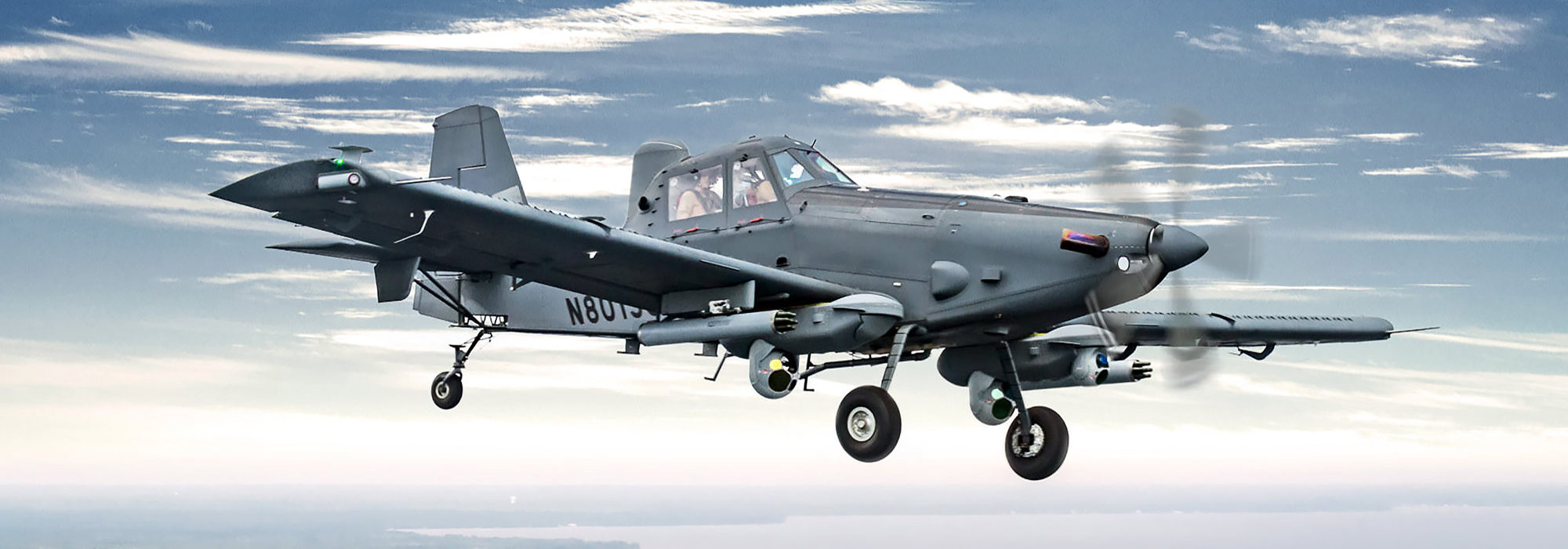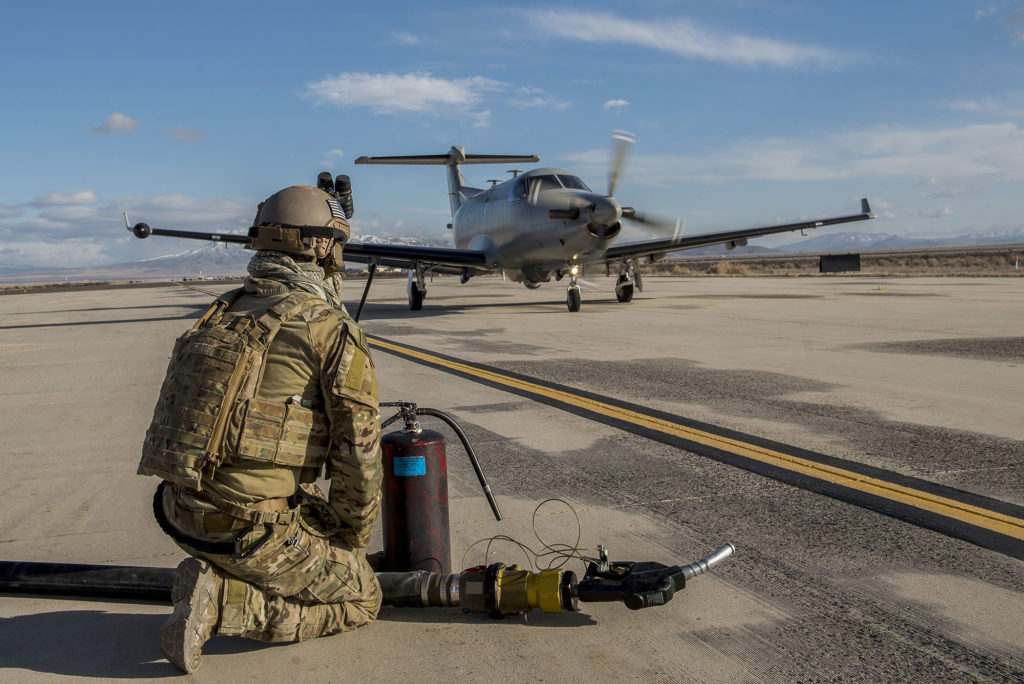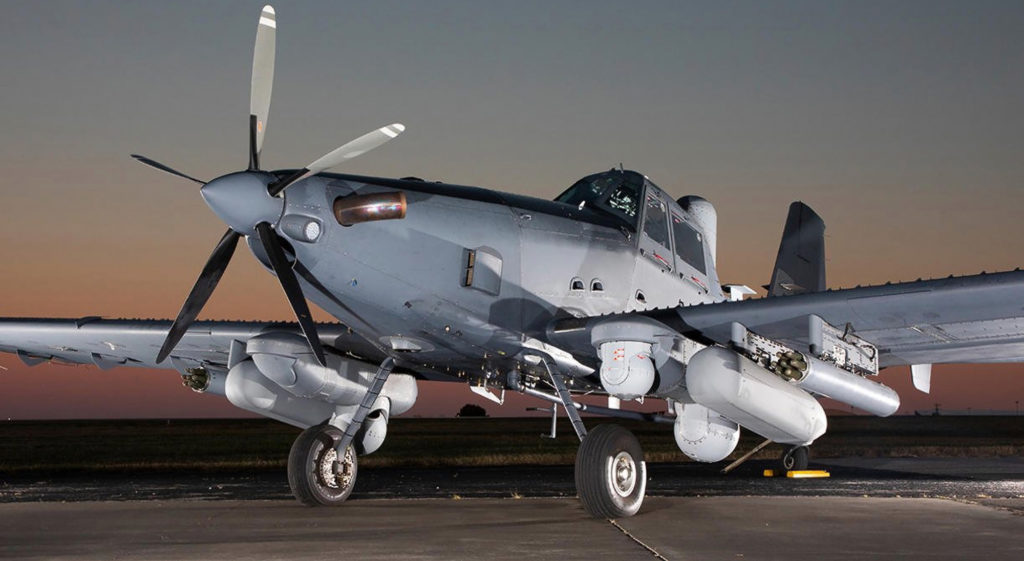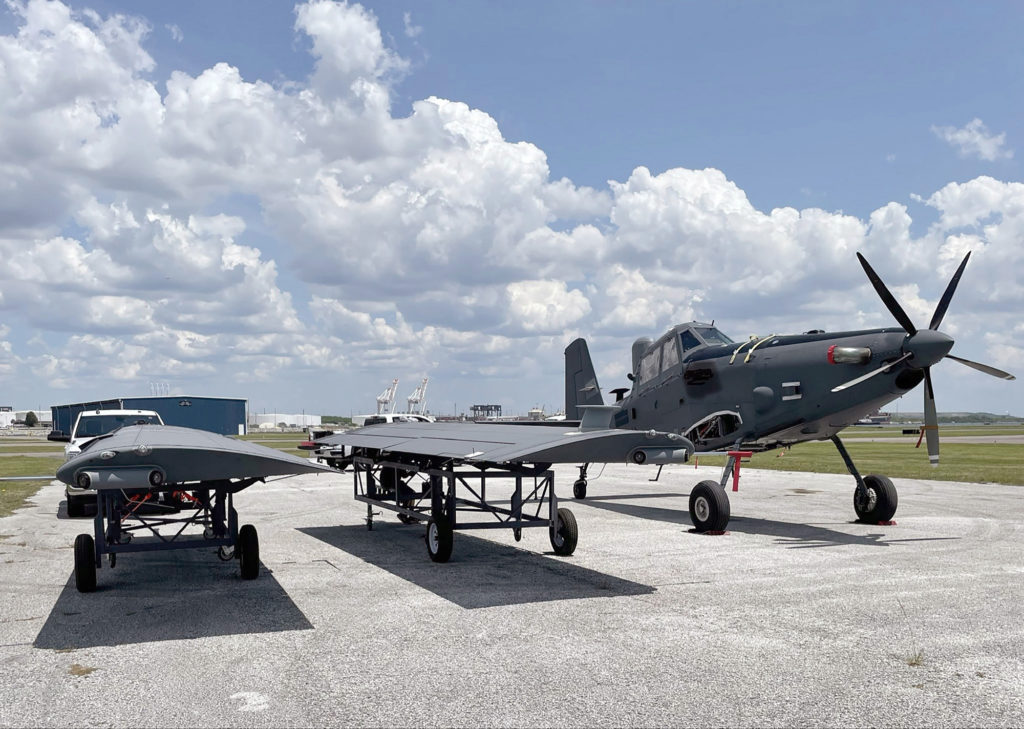In Sky Warden, AFSOC gains a flexible new hunter-killer.
An eight-vehicle convoy of U.S. Special Operations troops and Nigerien soldiers departed the village of Tongo Tongo in October 2017, following a short resupply stop a day after a failed raid on a target. Almost immediately, the troops’ armorless pickup trucks and Toyota Land Cruisers were surrounded by heavily armed militants from ISIS in the Greater Sahara (ISIS-GS). On motorcycles and in pickups, the militants overwhelmed and fragmented the convoy, killing four U.S. Soldiers and five Nigeriens.
Investigators would later conclude the team had been left totally unprotected from the air; a U.S. drone that tracked the convoy earlier in the mission had been sent north to the Mali border and when the team had called for help, it took almost an hour for a French Mirage aircraft to reach the areas.
The ambush highlighted a gap in U.S. military capability—the lack of a small, nimble, and flexible Armed Overwatch platform able to provide surveillance, close air support, and precision strike in the austere and permissive environments that U.S. special operations forces operate in routinely. In August 2022, nearly five years after the Tongo Tongo incident—and two years after U.S. Special Operations Command launched a search for such a capability—SOCOM selected a modified crop-duster from L3Harris for the mission.
SOCOM will invest about $170 million to build 75 Sky Warden aircraft based on the Air Tractor single-engine turboprop AT-802U. To start, Sky Warden will replace Air Force Special Operations Command’s aging fleet of U-28A Draco ISR aircraft and in turn augment the Air Force’s remotely piloted MQ-9 Reaper drones. But AFSOC and other experts anticipate an expanding role for this simple platform, which requires a very small footprint to operate in the wild.
Instead of running a bill of up to $150,000 per hour for a complex stack of air assets, the Sky Warden can fulfill much of the same for … pennies on the dollar.Retired Maj. Gen. Michael Kingsley, former USAFRICOM chief of staff
Sky Warden is designed to “collapse the stack” of up to 20 ISR and armed defense aircraft that are sometimes called in to support missions like the failed 2017 operation in Tongo Tongo. Retired Air Force Maj. Gen. Michael Kingsley, who led U.S. Africa Command prior to his 2016 retirement, said that stack can include ISR assets like the Draco, unmanned platforms like the Reaper, and manned fighters like the F-16 to validate and act on intelligence.
“We’re entering into a world now, where a majority of the fighters and other airplanes, to include remotely piloted airplanes, are going to be focused elsewhere,” Kingsley said. Russia’s war on Ukraine and China’s increased assertiveness in the Pacific is changing U.S. defense priorities, and counter-insurgency and counter-terrorism missions may not always be able to garner the attention and commitment of forces needed.
“Instead of running a bill of up to $150,000 per hour for a complex stack of air assets, Kingsley said, the Sky Warden can fulfill much of the same requirement for an hourly operating cost in the low thousands—‘Pennies on the dollar.’”
Kingsley has a history with the Air Tractor aircraft, having been a vice president at IOMax USA, which created an earlier armed version of the Air Tractor flown by the United Arab Emirates Air Force.
PLANS FOR SKY WARDEN
Sky Warden won out over five competing options using an Other Transaction Authority (OTA) competition intended to accelerate acquisition. The first batch of seven aircraft are due in fiscal 2023, and Air Force Special Operations Command anticipates 75 planes by the end of fiscal 2029. The 18th Special Operations Test and Evaluation Squadron at Eglin Air Force Base, Fla., will start putting the aircraft through its paces by the end of calendar 2023. Ahead of that, contractor and government verification testing is already underway at L3Harris facilities in Waco, Texas.
“We’re basically buying this complete production aircraft off the shelf, like a fully mature aircraft,” said Maj. Alex Flori, branch chief for Armed Overwatch requirements at headquarters, AFSOC.
AFSOC officials told Air and Space Forces Magazine to see the platform as perfectly in tune with the Air Force’s Agile Combat Employment concept for rapid, small-footprint deployments. Because the plane is a relatively simple, low-maintenance aircraft and can land and take off easily from unimproved roads, it doesn’t require the kinds of maintenance support and facilities required of jet aircraft like the A-10 Thunderbolt. As a bonus, its load capability and low operating costs make it a potential fuel supply platform; in a pinch, it could deliver enough fuel to fill the tanks of a UH-60 Black Hawk.
“There’s definitely room for expansion of mission capability,” Flori said, citing the palletized munition initiative that has turned C-130s into makeshift bombers, capable of launching missiles and munitions from their cargo bays. “I think SOCOM and AFSOC have a long, long history of doing this on our aircraft.”
AFSOC and the Air National Guard Bureau will stand up in the second quarter of fiscal 2024 at Will Rogers Air National Guard Base, Okla., with an initial cadre of 24 U-28 and MC-12W Liberty pilots. The unarmed MC-12 turboprops are Guard ISR planes. By 2029, the Air Force anticipates retiring the U-28s, with pilots transferring to other aircraft.
“I think the experience you would gain on a U-28 as a senior pilot or a command pilot would translate well to an Armed Overwatch squadron,” Flori noted. “Slightly different mission, but those experiences as an Airman still translate.”
THE AIRCRAFT
Sky Warden isn’t really like anything else in the aircraft stack it’s supposed to replace. It has a crew of two compared to the Draco’s four, and its 18-meter wingspan dwarfs that of an F-16. With chunky tires built for primitive airfields and a NASCAR-style roll cage to protect the crew, “it’s structurally just a tank,” said John Totty, a former Army and Air Force pilot who has helped with developmental test and demonstration flights. “It’s a phenomenal airplane that will take a tremendous amount of punishment.”
Similar in size to the A-10, the beloved close air support platform that is sometimes criticized for flying too slow, Sky Warden is even slower: Its top speed of 213 knots is about half that of the A-10. But its tailwheel design is well suited to austere environments, keeping the aircraft’s nose up during landings to ensure the prop stays clear of grass or other obstacles.
“When I saw the aircraft, being a tail-dragger pilot, I loved it,” said Totty, who previously flew Russian Antonov An-2 Colt biplanes, another tailwheel aircraft that was adapted for military service. “And the fact that they could take this very utility-oriented crop-duster, and turn it into a military machine, you know, was really intriguing.”
Totty said the Air Tractor proved its low-maintenance bona- fides in testing. At the joint exercise Bold Quest 21 in southern Indiana last November, he said, it supported Airmen, Marines, and other troops from 11 partner nations over nine days and 50 hours of flight time without any “squawks,” or mechanical issues. Advertised as able to spend eight hours airborne on station, Totty said testers found they could reliably get more than nine under the right conditions. They gave Sky Warden high marks for reliable performance and ease of maintainability, noting it needed little more than oil and tire changes between flight days, he said.
L3Harris gave Sky Warden two FMV ISR sensors; four secure mission radios, in addition to its two standard air traffic control radios; Ku band and UHF satellite communications; Link 16 networking capability; and a Mobile Ad hoc Networking (MANET) digital radio that allows teams on the ground to control and aim the mounted sensors and view the data the aircraft is collecting via a video feed on a tablet.
Multiple hardpoints support a significant weapons load. The aircraft can haul combat loads up to 6,000 pounds and can launch GBU-12 Paveway II 500-pound bombs; AGM-114 Hellfire Missiles; stand-off precision-guided munitions fired from 8x common launch tubes; and 70 mm rockets, such as the Hydra 70 or AGR-20 Advanced Precision Kill Weapons System, reportedly the Sky Warden’s primary armament.
SKY WARDEN VS. MQ-9
Loaded up with sensors and weapons stations, tough to destroy and easy to maintain, the Sky Warden checks the boxes for its designated mission to protect exposed ground troops and surveil targets in austere regions. Critics see its slow speed and limited maneuverability as a vulnerability, making it a fat target in a world where sophisticated and powerful counter-air weapons are increasingly available.
But Kingsley, the former AFRICOM chief of staff, said in the parts of Africa where Armed Overwatch is needed, Sky Warden can operate safely at 10,000 feet now and for a long time to come.
“The surface-to-air threat there is minimal—probably just small arms,” he said. “There might be a [rocket-propelled grenade] or two. But just saying they’re going to get and be able to operate advanced shoulder-fired missiles against our aircraft, I’m a skeptic with that.”
Kingsley said AFSOC’s purchase of Sky Warden is likely to fuel interest in foreign military sales to allies such as Nigeria, and that their purchases will allow those countries to better control militants operating inside their borders.
Armed Overwatch was needed largely because the Air Force’s fleet of 300 MQ-9 Reapers is already overtasked and costly to operate, which led to coverage gaps like the one in the case of the Tongo Tongo ambush. But Sky Warden advocates see other advantages, too.
“In my world and the platforms I make, I’ll never make an airplane that only has one [electro-optical/infrared] sensor on it again,” said Luke Savoie, president of L3Harris Technologies and a former Air Force evaluator pilot. “It is very hard to maintain chain of custody of targets, to increase your situational awareness … especially after someone has come into an area and left an area—and to make a decision—especially when you’re making a decision to shoot a weapon. It’s very hard to do that with only one sensor.”
The Sky Warden’s two EO/IR sensors compared to the MQ-9’s one mean it can track multiple objects with high fidelity simultaneously, accelerating pilots reaction time, Savoie stated.
“Our time is measured in milliseconds, not seconds, for our operators to observe and react to things that they see,” he said. “So you’re not waiting on the latencies and the delays of getting to someone looking at it on the other side of the planet.”
Totty said there are also advantages in some cases to having a crew on scene versus operating an aircraft remotely.
“There are some risks involved anytime you deploy an unmanned system, because you don’t have the aircrew on station, and you have to control that machine via a link,” he added. “In the Sky Warden, [there are] crew onboard who are able to see and monitor ops within and outside the sensor fields of view, with their hands on the flight controls so no one else can interfere with what the aircraft’s going to do, and the targets that it services.”
SUCCEEDING WHERE OTHERS FAILED
Despite its estimation that Armed Overwatch was an urgent need, SOCOM had to convince Congress and others. The fiscal 2020 National Defense Authorization Act barred the Defense Department from investing in Armed Overwatch until an independent study validated the requirement and the Air Force’s inability to meet the need with existing aircraft. RAND completed the study in March of this year, but although the study has not been publicly released, its impact is evident.
Both the House and Senate versions of the fiscal 2023 defense bill fund Armed Overwatch with the full $246 million requested by DOD. That makes Sky Warden a rare success among at least half a dozen DOD efforts to purchase modified commercial aircraft for surveillance and attack mission. The most recent bust was the Air Force’s Light Attack Experiment, which stalled out after a decade of effort and hundreds of millions spent. The Light Attack program culminated in a four-aircraft evaluation event in 2017, but a combination of confusion over how the aircraft would be used and where it fell in the priority list ultimately meant it did not move forward. Air Tractor’s armed AT-802U was an unsuccessful competitor in that competition.
Savoie said Armed Overwatch benefited from a clear and coherent mission description and powerful advocacy from senior leaders such as AFSOC commander Lt. Gen. James C. Slife and SOCOM Commander Army Gen. Richard D. Clarke, who each made passionate pleas to Congress in testimony last year.
“I think you could look at the quotes from General Clarke at the time, you can look at the quotes from Lieutenant General Slife, and you can clearly see the articulated need, and how it fits into their scheme of maneuver to the overall national defense strategy,” Savoie said. “The continued war to counter violent extremists is a continuing mission step, but it has to be done with less assets than the conventional force needs to focus solely on the near-peer or peer threat in [U.S. European Command] or [U.S. Indo-Pacific Command]. Then, it makes perfect sense.”
Communication with Congress and responsiveness to lawmakers’ concerns was also key, Air Force Capt. Cory Moore, acquisitions officer for the Armed Overwatch branch, said in an interview.
“Some of the homework they provided us was to weigh risk/reward and was also to balance against what is the mission that Armed Overwatch entails,” Moore said. “Once we were clear on those definitions, we provided a good roadmap to pursue.”
BEYOND ARMED OVERWATCH
Sky Warden may be a candidate to replace Javaman, a little-mentioned MC-12W mission.
“Everything that Javaman did, Sky Warden certainly can do with additional capability, because it brings the agile strike capability,” Totty said.
Savoie also expects the Defense Department’s commitment to Sky Warden to affect international sales, instilling confidence in customers leery of investment in an off-the-shelf tactical aircraft after the foundering of the Light Attack program. It’s also a proof of concept, he added, for defining a problem and developing a tailored solution, rather than settling for a more accessible proximate fit.
It’s part of that entire paradigm shift that we’re doing of how to fight a little bit differently, so the same type of things with the same effects, but approach those problems differently,” he said. “And I love that the platform is kind of a forcing function for that.”
Totty also expects Air Force and SOCOM operators to develop uses that haven’t even been imagined yet as they get acquainted with the platform.
“We’ve met all the requirements that they were looking for in an airplane that will take the punishment over the long haul. They can rapidly deploy it; you can pull the wings off, you can ship the airplane somewhere. We’ve proven that they can do that with a very low footprint,” he said. “But honestly, it’s engineered to go well beyond [requirements] knowing that when we put that airplane in the hands of these AFSOC aircrews and their ingenuity, and they start writing the tactics, techniques and procedures for their mission set, that’s when we’re really going to see the value.”



